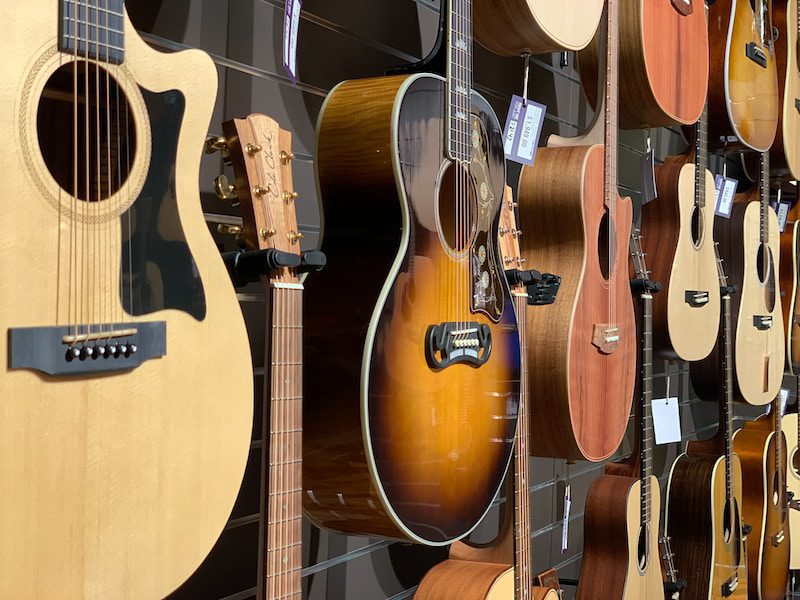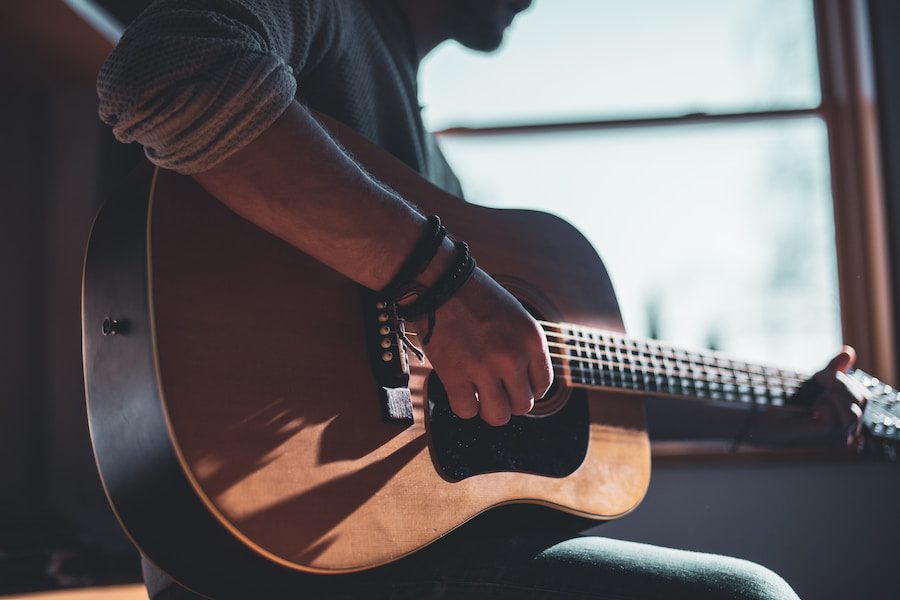Two popular body styles stand out for acoustic guitars: the Dreadnought and the Concert. Both types of guitars have their unique characteristics and advantages, which make them appealing to various musicians. This article explores the differences between Dreadnought and Concert guitars, helping guitarists decide when to choose their next instrument.
The Dreadnought guitar, first introduced by the Martin Guitar Company in 1916, has become a defining symbol of American folk and country music. Notable for its large body, broad waist, and square shoulders, the Dreadnought delivers a powerful, bass-heavy sound well-suited for strumming and flat-picking. In addition, its strong sonic projection makes it a popular choice among performers who require a guitar that can hold its own among other instruments.
On the other hand, the Concert guitar originated in Europe during the 19th century and is known for its smaller body size and curvier shape than the Dreadnought. It produces a more balanced tonal spectrum, highlighting the mid-range frequencies. This results in a clearer and more articulate sound, making it a popular choice for fingerstyle players and those who prefer a more delicate touch on their instrument.
Table of Contents
- Historical Background
- Design Differences
- Tonal Characteristics
- Music Genres and Playing Styles
- Pros and Cons
- Buying Considerations
- Final Thoughts on Dreadnought Vs. Concert Guitar

Historical Background
The history of the guitar spans centuries, styles, and genres. With a rich and diverse background, the development of the dreadnought and concert guitars cater to specific musical preferences and playing styles.
Dreadnought Guitar

The dreadnought guitar, named after the British battleship HMS Dreadnought, was introduced by the Martin Guitar Company in 1916. Its larger body size and unique design set it apart from other guitar styles, offering a powerful and resonant sound. Initially, the dreadnought was met with resistance from traditionalists, but its popularity soared in the mid-20th century due to its use in folk, country, and bluegrass music.
Some key features of the dreadnought guitar include:
- Large body size for increased volume and projection
- Square shoulders for enhanced bass response
- Wide waist for better balance and stability
- 14-fret neck, encouraging a more modern playing style
Concert Guitar

The concert guitar, also known as the classical or nylon-string guitar, traces its origins back to Spain in the late 18th and early 19th centuries. Luthiers such as Antonio de Torres and Hermann Hauser contributed to developing the modern concert guitar, establishing its distinct design elements and characteristics.
Intended for use in smaller, more intimate settings, the concert guitar offers a more delicate and nuanced sound than the powerful dreadnought. Famous classical guitarists like Andrés Segovia and Julian Bream showcased the expressive capabilities of these instruments in traditional concert settings.
Distinct features of the concert guitar are:
- Smaller body size for a lighter, more intimate tone
- Cedar or spruce top for warmth and resonance
- Wide neck with a flat fretboard to facilitate intricate fingerstyle playing
- Nylon strings for a softer, more mellow sound
Design Differences
When comparing dreadnought and concert guitars, there are several key design differences to be aware of. These factors contribute to each type of guitar’s unique sounds and playing experiences.
Body Size and Shape
Dreadnought guitars typically have a larger body size compared to concert guitars. This larger body contributes to a more resonant sound and deeper bass response. Its broader waist and square-shouldered silhouette characterize the shape of a dreadnought guitar.
On the other hand, concert guitars have a smaller, more curvaceous body shape. This design results in a more comfortable playing experience for some guitarists, particularly those with smaller frames. The concert guitars’ compact body shape produces a more focused and balanced sound.
Scale Length
The scale length of a guitar refers to the distance between the nut and the saddle, affecting playability and string tension. Dreadnought guitars generally have a longer scale length, which contributes to their louder sound but may make it harder for some players to play higher frets easily.
Concert guitars, on the other hand, usually have a shorter scale length, making it easier for those with smaller hands or shorter fingers to play. Moreover, the shorter scale length offers a warmer sound with less overall volume.
Tone Woods
Both dreadnought and concert guitars come in various wood options, affecting their tonal characteristics. Common wood choices for dreadnought guitars include mahogany and rosewood, which can deliver a rich and full sound.
Table of common tonewoods for dreadnought guitars:
| Tone Wood | Characteristics |
|---|---|
| Mahogany | Warm, deep sound with pronounced mid-range |
| Rosewood | Rich and balanced, with clear highs and deep lows |
Concert guitars often combine different woods to achieve a more balanced sound. Spruce tops on concert guitars provide a bright and articulate tone, while cedar tops offer a warmer and mellower sound. The back and sides might be made from materials such as mahogany, maple or rosewood, with each wood type adding its distinctive sonic signature.
Table of common tonewoods for concert guitars:
| Tone Wood | Characteristics |
|---|---|
| Spruce | Bright and clear, with crisp high frequencies |
| Cedar | Warm, mellow sound with smooth highs |
| Mahogany | Mid-range focused, with a balance of warmth and brightness |
| Maple | Transparent and articulate, with a balanced tone profile |
| Rosewood | Well rounded, with resonant bass and clear treble frequencies |
Tonal Characteristics
Dreadnought Sound
The dreadnought guitar is widely known for its robust and powerful sound. This is mainly due to its large body size and deep resonating chamber, which enables the guitar to produce a considerable volume and dynamic range. The tonal characteristics of dreadnought guitars are particularly associated with a strong bass response and a well-balanced sound, making them suitable for various genres, including country, rock, and bluegrass.
One of the main contributors to the unique sound of dreadnought guitars is their strong presence in the lower frequency ranges. This results in a warm, full-bodied tone, often slightly favoring the bass and mid-range frequencies.
Concert Sound
On the other hand, concert guitars feature a smaller, more streamlined body shape, which lends itself to a more focused, articulate sound. Due to its reduced size and shallower depth, the concert guitar is known to have a more delicate tonal balance. This allows for a greater emphasis on the higher frequency range, resulting in a brighter and more sparkly treble response.
Because of its less prominent bass response, the concert guitar’s sound may sometimes be perceived as thinner or more “boxy” when compared to the dreadnought. However, this unique tonal characteristic makes concert guitars ideal for fingerstyle playing and genres that require a more subtle, nuanced touch, such as classical and folk music.
The following table summarizes the key differences in the tonal characteristics of dreadnought and concert guitars:
| Feature | Dreadnought | Concert |
|---|---|---|
| Bass Response | Strong | Less Prominent |
| Mid-range Frequencies | Well-balanced | Focused |
| Treble Response | Clear | Bright and Sparkly |
| Volume and Dynamic Range | High | More Modest |
Music Genres and Playing Styles
When choosing between a dreadnought or concert guitar, it is important to consider the music genres and playing styles for which each type is suitable. This section will explore the musical genres and playing styles where dreadnought and concert guitars excel.
Dreadnought Suitability
Dreadnought guitars are known for their robust and versatile sound. They are particularly popular in the following playing styles and genres:
- Country music: The loud, boomy sound of the dreadnought guitar is a staple of traditional country music, making it an ideal instrument for this genre.
- Bluegrass: The dreadnought’s ability to cut through the mix is perfect for bluegrass music’s fast, energetic sound.
- Folk: The strong bass response and projection of the dreadnought guitar are essential to the folk music sound.
- Rock: Dreadnought guitars can also handle rock music well, particularly for rhythm guitar parts and acoustic arrangements.
The dreadnought’s powerful sound and versatility suit various genres and playing styles.
Concert Suitability
Concert guitars, on the other hand, are known for their more delicate and balanced sound. They are particularly popular in the following playing styles and genres:
- Classical music: Concert guitars offer a more nuanced sound, making them a popular choice for classical guitarists who require greater control and subtlety when performing.
- Flamenco: The lively and bright tones of the concert guitar, combined with its lightweight design, make it suitable for the dynamic playing style of flamenco music.
- Fingerstyle: The concert guitar’s balanced tonality makes it an excellent choice for fingerstyle guitarists, as it captures intricate fingerpicking patterns’ subtleties.
- Indie and alternative music: The concert guitar’s distinct tonal characteristics are well-suited to indie and alternative music styles, where a unique and expressive sound is often desired.
In conclusion, the concert guitar’s refined sound and responsiveness make it an excellent choice for players who require precision and control in their playing style or want to explore more delicate or expressive musical genres.
Pros and Cons
Advantages of Dreadnought Guitars
With their large body size, Dreadnought guitars are known for producing a powerful and loud sound. This makes them ideal for players who need strong projection in their performances, especially in a band context where the guitar needs to compete with other instruments.
Another advantage of dreadnought guitars is their deep and rich bass response. The lower frequencies resonate well within the large body, providing a warm and full-bodied tone, especially when playing chords and rhythm patterns.
Advantages of Concert Guitars
Concert guitars, on the other hand, are smaller, making them easier to handle and more comfortable for many players. The smaller size is particularly beneficial for those with smaller hands or who prefer playing while sitting down, as the guitar rests more comfortably in the lap.
Their smaller body also provides a more focused and balanced sound. This results in greater clarity in the higher frequencies, which can appeal to fingerstyle players or those who value precision in their playing.
Disadvantages of Dreadnought Guitars
While the larger body of dreadnought guitars provides a powerful sound, it can also make them more difficult to play for some. The size can be cumbersome, especially for those with smaller hands, younger players, or people with mobility issues.
The powerful and loud sound of dreadnought guitars might come at the cost of tonal balance. Some players may find the bass frequencies too prominent or overpowering, leading to the higher notes being overshadowed in a mix.
Disadvantages of Concert Guitars
Concert guitars may not suit those seeking a big, powerful sound. The smaller body size results in a quieter volume and less powerful projection, which may not be ideal for some performance situations or styles of music that require a more dominant guitar sound.
The focused and balanced tone can sometimes result in a lack of versatility, as the concert guitar may not excel in providing the rich, deep bass response that some music styles or players prefer.
Buying Considerations
When deciding between a dreadnought and a concert guitar, there are several factors to consider. These factors include price range, skill level, and brand recommendations. This section will discuss these aspects in more detail to help you make an informed decision.
Price Range
Dreadnought and concert guitars come in different price ranges, catering to various budgets. Typically, entry-level models start at around $100, while high-end, professional-grade guitars can cost thousands of dollars.
It’s essential to determine your budget before making a purchase. Here’s a rough breakdown of what to expect in different price ranges:
- Under $300: Beginner models with basic features and materials.
- $300 to $1000: Intermediate guitars featuring better wood and components for improved sound and durability.
- Over $1000: Advanced and professional-level guitars which use premium wood, hardware, and advanced craftsmanship for top-quality sound and playability.
Skill Level
Your skill level is crucial when choosing between dreadnought and concert guitars. Beginners might prefer concert guitars due to their smaller size and ease of playability. In contrast, advanced players may lean towards dreadnoughts for their larger sound and projection, especially if they play in live settings or bands.
However, this is not a universal rule and individual preferences may vary. Therefore, trying out different guitars and finding what suits your playing style and skill level is always the best approach.
Brand Recommendations
Many reputable guitar brands are on the market, each offering a unique combination of quality, craftsmanship, and sound. Some of the most popular brands for both dreadnought and concert guitars include:
| Brand | Dreadnought | Concert |
|---|---|---|
| Yamaha | Yamaha FG800 | Yamaha FS800 |
| Martin | Martin D-28 | Martin 000-18 |
| Taylor | Taylor 210ce | Taylor 114ce |
When selecting a guitar, always research the brand’s reputation, reviews, and offerings in your chosen price range. This will help ensure you make the right decision based on your needs and preferences.
Final Thoughts on Dreadnought Vs. Concert Guitar
One must consider each individual’s playing style and preferences when comparing the dreadnought and concert guitars. The dreadnought offers a powerful and bold sound, making it a popular choice for bluegrass, country, and rock players. Its deep bass tones and projection make it suitable for powerful strumming patterns.
On the other hand, the concert guitar has a more balanced tone that is ideal for fingerstyle playing and intricate picking patterns. Its smaller size makes it more comfortable for players of various body types while offering adequate volume and projection.
In summary:
- Dreadnought guitars are known for their powerful sound and deep bass tones.
- Concert guitars offer a well-balanced tone and are better suited for intricate playing styles.
- Both types of guitar cater to different playing styles and preferences, so careful consideration should be given to which one is most suitable for your needs.
Ultimately, both dreadnought and concert guitars have their unique characteristics and benefits. By understanding these differences and considering the playing styles that best suit each instrument, a player can make an informed decision when choosing their next guitar.
- Review of the ALABS IRON MINI-WL: A Powerhouse Wireless Microphone - October 4, 2023
- What is a Saturator in Music Production: A Brief Explanation - May 11, 2023
- What Are Rotary DJ Mixers? An Overview - May 11, 2023
SoundStudiomagic.com is a participant in the Amazon Services LLC Associates Program, an affiliate advertising program designed to provide a means for sites to earn advertising fees by advertising and linking to Amazon.com. We also participate in other affiliate programs which compensate us for referring traffic.

